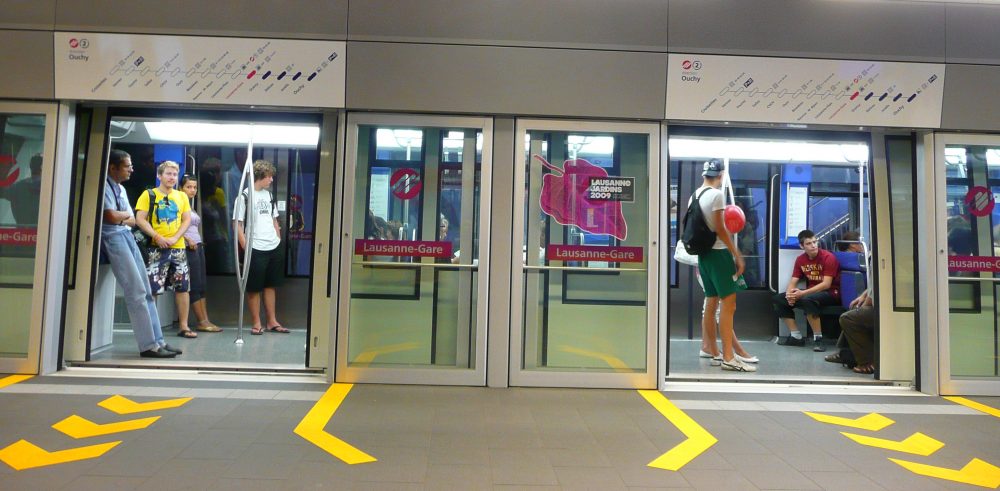Introduction
While walking to class one afternoon, we were talking about where we wanted to base our linguistic landscape. We came up with a number of ideas but we thought that the obvious choices like downtown or Ouchy would be taken by other students. We wanted to choose somewhere that was untouched by other research. As we walked down the street, we realized how much of the English language we saw just on our little walk to class in Bourdonnette. That was when we did some research about our neighborhood and realized that it would be the perfect option.
We decided to choose the neighbourhood of Bourdonnette as a location for linguistic landscaping for a variety of reasons. Firstly, it was a practical option since we live close by, with a rich immigrant history. Since our arrival in Lausanne, we have both been curious about the neighbourhood in which we live and decided to use this as an opportunity to explore and learn about where we live through the eyes of linguistic landscaping. Furthermore, Bourdonnette is a diverse area that has remained largely unexplored by many in Lausanne. By conducting this study on Bourdonnette, we have learned an unexpected amount about where we are living and the rich linguistic diversity behind its walls.
In order to carry out this experiment, we posed the following research questions: What do the multilingual signs indicate about the Bourdonnette neighbourhood? Do they reflect the population living there? What foreign languages are used? By answering these questions, we hope to uncover the linguistic background and representation of the area.
Methodology
Prior to carrying out much of our research and finding multilingual photographs, we had several hypotheses surrounding what we expected to find. We expected there to be more English used as a lingua franca due to the amount of immigration in the Bourdonnette area. We further predicted that we would find a multitude of different languages in the area, also due to the high rates of immigration. However this was not the case. We only came across one example of several international languages being present in one spot and it was the official languages of Switzerland (even then, Romansch was not present).
There is so much history of Bourdonnette and the surrounding area and we thought it would be very interesting to take a closer look at the demographic of the neighborhood. Bourdonnette is a working class neighbourhood. Stereotypically, in working class neighbourhoods, not everybody who lives there has a university education which means that this was most likely not a way in which the local people became bilingual or multilingual. Even so, there are so many multilingual signs and advertisements that the need had to arise for them from somewhere. Interestingly, we found that Lausanne has a 42.9% immigrant population (City Statistics Portait 2017). People from all over the world settle down in the Bourdonnette neighborhood and nearby areas instead of a more expensive neighborhood downtown. English is clearly used as a lingua franca here, though not to the extent we were expecting. With so many different people who all speak different languages, there was no way to represent all of the different languages so they used one that the majority of people probably knew, which was english. We took a lot of photos in and near a low-income housing complex where many of these immigrants most likely live. Therefore, we saw a substantial number of multilingual signs around the area. The last reason this neighborhood was of interest to us was because of the proximity to two large universities in Switzerland. With UNIL and EPFL minutes away, this area is populated by many international students who are living here short term, especially in the designated student housing complexes around the neighborhood. We are very excited to use this background and history to find evidence of the multilingual footprint left in Bourdonnette.
We were initially captivated by soundscaping in the Bourdonnette, as we were accustomed to hearing many different languages throughout the neighbourhood. As we walked through the area, we were captivated by the multitude of foreign languages we heard. However, while we did not find as many visual representations of foreign languages as we had hoped, we often came across a rich oral array of foreign languages. We felt that while this was not necessarily part of the project, that it was an important topic to discuss. As Bourdonnette is heavily populated with immigrants, it is unsurprising to be confronted with languages other than French. For instance, in the Denner Satellite, we often hear the employees speak to each other in languages other than French. We have not had the chance to ask them about what language they are speaking, though it seems to be of an Eastern European domain. Another example of oral language diversity is next to the daycare, where there is a playground. While walking through Bourdonnette to come to university, we often come across families with their children. We hear the parents address both their children as well as other parents. The parents often speak to their children in their native tongues and to each other in accented French.
Statistics
Bourdonnette sits on the border of Lausanne and still technically part of the area, therefore all the data that we found about the demographic of Bourdonnette is about Lausanne in general. While we know this is not necessarily representative of the specific area of Bourdonnette, we thought it was a good starting point. The data that we found also still supports our claim. According to the 2016 census, there are 135,629 permanent residents in Lausanne, 42.9% of those being permanent foreign residents and 15% of those foreign residents do not originate from the EU. This is a very high statistic for one city and backs up our claim of why there seem to be so many multilingual signs and different languages around the Bourdonnette area. We hear more than french being spoken because people immigrate here from all over the world to be a part of the 73.94% employment rate that is here in Lausanne. It makes sense that multilingual advertisements and informative signposts are needed to reach all these different people which are mostly in english to reach the majority (City Statistics Portrait 2017).
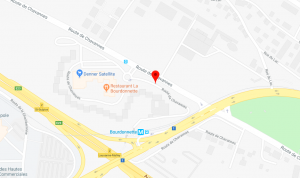
Black Angus
In the middle of the apartment complex, there is a Denner Satellite. Hanging on the outside door to attract customers is where we found this photo. This photo can be considered a commercial discourse. This is an appropriate spot for the poster as the steak is presumably sold in the store. The use of English here is interesting because it lends an authenticity to the cut of meat, as it evokes a northeastern scottish feel (where angus originates from). Though the rest of the sign is in French, meaning that the remaining information is able to be read by the general public. Finally, it is clear that the sign has been professionally printed, meaning that the company has invested money into the advertising of this product. Due to the fact that Denner is a major company, they have presumably done research on how their different products sell when advertised in different ways — this includes language. One can therefore assume that the English is a necessary part of the sign advertising the black angus steak.
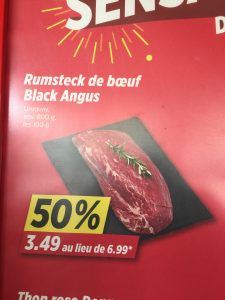
TV Bourdonnette
Commercial discourse because that is the name of the establishment. After supplementary research on this establishment, we discovered that Bourdonnette TV seems to be a sort of news agency that publishes and diffuses information concerning the neighbourhood. It is worth noting that when one visits the webpage for this business, the primary heading is in English: “TV Bourdonnette” with a French translation underneath, written in much smaller font: “La télé de la Bourdo”. This is particularly interesting because, in our opinion, they carry different meanings, due to the less formal version of the word “Bourdonnette” in French. This could be because the establishment assumes the majority of the population living in the area knows the area well and will be familiar with the slang term for the neighbourhood. The other reason we thought this might have occurred is to lend a air of prestige to the channel, therefore putting it in English due to the fact that a large part of media is produced in English. Lastly, when one continues on their website, its contents are only available in French, leading us to believe that most of the people living in the surrounding areaare in fact fluent or at least comfortable in the language.
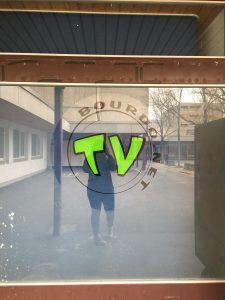
LycaMobile
This photo is obviously a commercial discourse sign because it advertises a product to the public by using the top-down method. It was not made by the public but by the owners of the company. It is important to note that on this advertisement, there is both English and French present, however they serve two different functions. The English appears to be their slogan: “Call the world for less.” While the French is providing details for the different phone plans. This is interesting as the company uses English to get people’s’ attention and then the French to provide more pertinent and specific information.
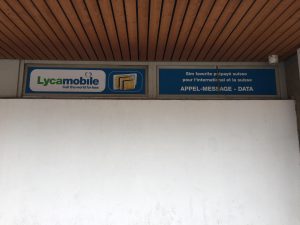
Pickup Assistance
This photo can be considered as a commercial discourse sign post because it is advertising a product, or service in this case to the public. This sign was very interesting to us because contrary to the other ones that we had found, this sign is completely in english. There is no french expansion in smaller font or anything to spread the message to french speakers. Either this means that french people can understand what is being advertised there because they are multilingual or the business is marketing straight to non-french speakers. There is a large market of non-french speakers due to the large number of permanent foreign residents in the area. We hypothesized that the word “pick-up” has been assimilated into the french language. Very similar to the words “shopping” and “week-end”. Therefore french speakers would know the meaning because they say it as slang on a regular basis.
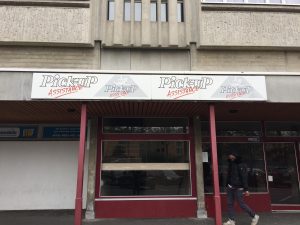
Saint-Prex
This photo was hanging on the window of a building as we were walking down the main street of Route de Chavannes. There was more than one of this poster so whoever hung them really wanted people to attend the concert. This photo is very clearly a commercial discourse sign because it is trying to persuade people to attend a concert, and using the bottom up method as well. We found this photo to be very emblematic of many examples of English in foreign languages (though particularly French). English is often adopted into French for a number of reasons. Since rock and roll originated in the United Kingdom and United States, it is often associated with the English language, therefore creating a link between the music and the language.
After having done additional research on the event itself, it proved be an unusual programme. Three of the six of the bands scheduled to play were from the 1980’s, with the other three being fairly recent. The latter of the bands have all recently produced music (2013-present).
Moreover, English is often used by the younger generation due to the influence of media on them. Since so much contemporary media and many popular celebrities come from North America, English is often associated and then adopted into French as it helps to connect adolescents with their idols. Therefore, the use of English on the poster could also have been an attempt at drawing a younger crowd to the concert, as half of the bands advertised could draw a potentially older crowd.
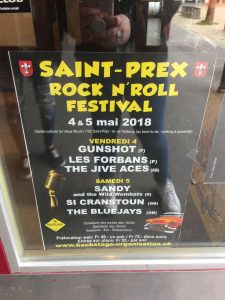
La Poste
Down the road, there is a post office where we found this informative photo. This photo surprised us the most because all of the other multilingual signs that we found just had English as a second language where this one had German and Italian attached as well. Since this sign is labeling rules to the public and displaying information, we decided to label it a regulatory discourse. While we understand this is a photo that is unique from the others — it is a standard Swiss government photo, it still surprised us. We were also surprised at the lack of Romansch and English on the sign. The sign includes French, German, and Italian (three of Switzerland’s four national languages). We have come to the conclusion that it is because there is such a small portion of the Swiss population that speaks Romansch as a first language. However, since this sign is at all of the post offices (presumably across Switzerland), we were shocked to find that Romansch was missing. Furthermore, we asked ourselves if the changed the post office signs in the canton of Graubünden, the only canton with Romansch as an official language. Do they change the signs in Graubünden to reflect one of the official languages of that canton?
As a post office is an official establishment, we assumed English would be used as a lingua franca for those who are not familiar with one of the four official languages of Switzerland, be it immigrants, tourists, or others. English is so often used in these scenarios to connect with the remainder of the world. Another reason we were surprised at the lack of English is because it seems to be so predominant on many of the other official signs and documentation. For instance, the Swiss passport includes all four official languages as well as English at the bottom (presumably for when Swiss people travel outside of Switzerland where the national languages may not be spoken).
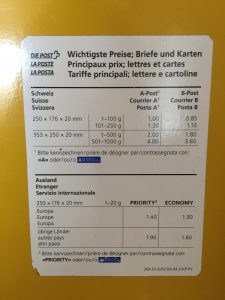
La Caisse Kids
We found this photo in the massive apartment complex that sits in the heart of Bourdonnette. This complex is so big that it has multiple restaurants, a grocery store, a hair stylist, and more but we found this box at the daycare. We decided to call this sign a transgressive discourse because someone had just painted it there on the box. There was no professional way that this sign was set up.
We have a number of hypotheses as to why there were English words written on the side of the box. Our first hypothesis is that as English is becoming increasingly important as a lingua franca throughout many domains of the world, perhaps it is a reflection of the attempt of the daycare to include the use of English vocabulary in their daily routines. By exposing the children to English words, they are more likely to retain them and develop an interest in the language later on.
Our second hypothesis stemmed from the fact that Bourdonnette is an immigrant heavy neighbourhood and that perhaps not all the families are fluent or comfortable in French. Therefore this could be seen as an attempt to connect with more children than they would have been able to if French were to be the only means of communication.
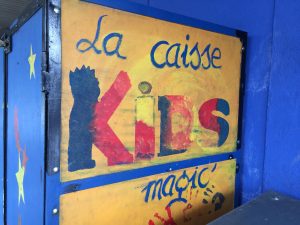
FMEL Residence
We came across this poster that is hanging on the outside of the door to the garbage room in the FMEL Bourdonnette complex. At first glance, we thought that this sign could be a commercial discourse because it was advertising the garbage room but on a closer level, we realized that it was notifying people about the correct procedures regarding the garbage room, therefore making this sign a regulatory discourse. At first, we were surprised to see two languages, but after some reflection, we came to realize that many of the students living in Bourdonnette are in the same situation as us — exchange students only here for a short period of time. With UNIL and EPFL only a few minutes away, this housing complex is the home to many students who do not have french in their language suitcase. In this case, English is used as a sort of Lingua Franca in order to communicate with everyone living in the complex. They found that having both of these languages on the same page could reach everyone. French could be considered to be the main language on the sign since it is at the top of the page followed by an English translation underneath.
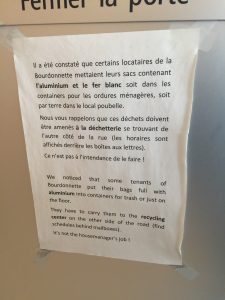
Discussion
While we did not find exactly what we had expected, we did find out a lot of interesting information about where we live and the community that surrounds us. One hypothesis as to why we did not find a wider array of languages is because the immigrant population of Bourdonnette may be constantly changing from year to year. Hence we hypothesized that English is perhaps used as a lingua franca in order to reach as many individuals in the community as possible. Due to the fact that the statistics we found concerning Lausanne, we understand that the numbers may not provide an accurate representation of Lausanne. Perhaps the most interesting find was the TV Bourdonnette as it seems to be very connected to the community. Because nearly all of its contents are written in French, it can be said that the lack of foreign languages in the area may in fact be representative of the population living in the area.
Conclusion
When we began this project, we predicted that we would find and interact with far more languages than we actually did, with English being the main international language present. As far as commercial signs go, we only ran into english, but for some of the informative or infrastructural signs, we saw more languages in order to inform people about something important such as postal rules. This study helped to see clearly what has been staring us in the face since we moved into the neighborhood. We learned that it is very important to be knowledgeable about the place that you live, even if it is only for a few months. Throughout this study, we came across many different languages and cultures and it made us reflect on how language is used in different contexts, and how it can mean different things. Language can be seen as both a social and political tool and everything in between. By conducting this research, one can come to understand the role language plays in a certain area and hence the dynamic between the language, the community, and its residents.
Works cited
Federal Statistical Office. “City Statistics Portait 2017.” Confederation Suisse, 2017, www.bfs.admin.ch/bfs/en/home/statistics/cross-sectional-topics/city-statistics/city-portraits/lausanne.html.
